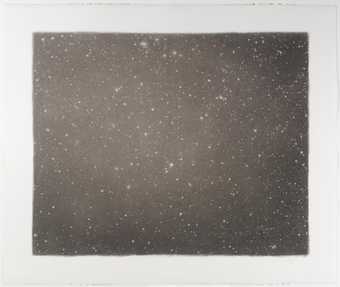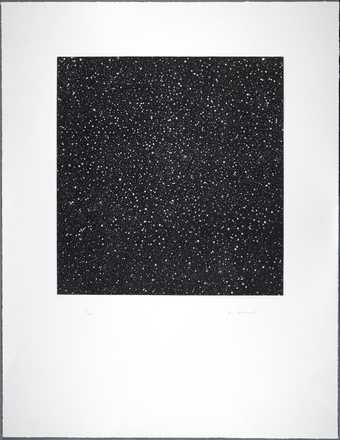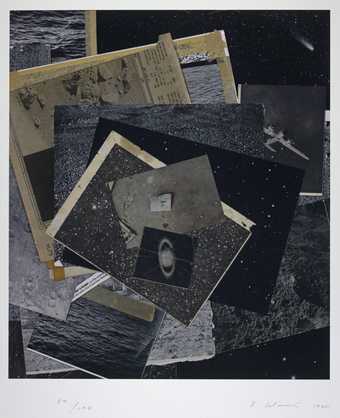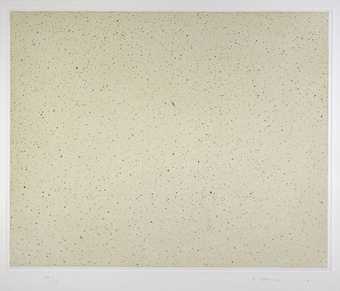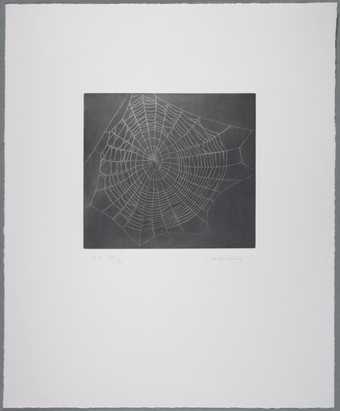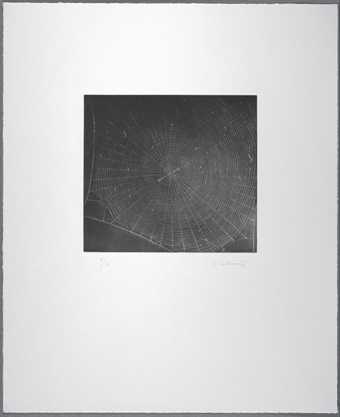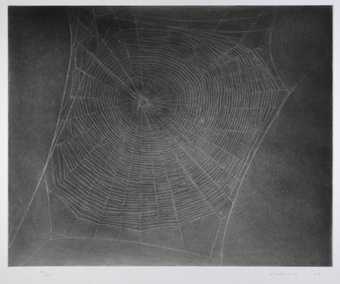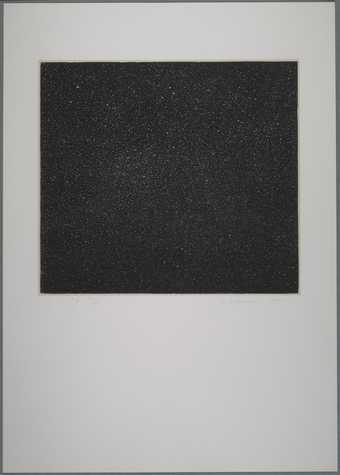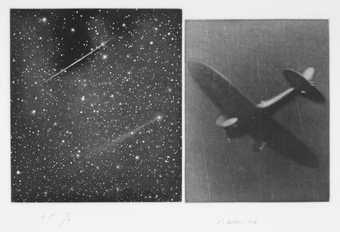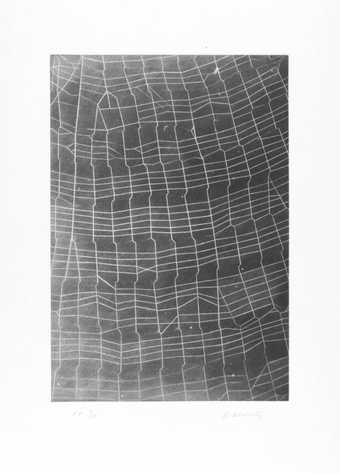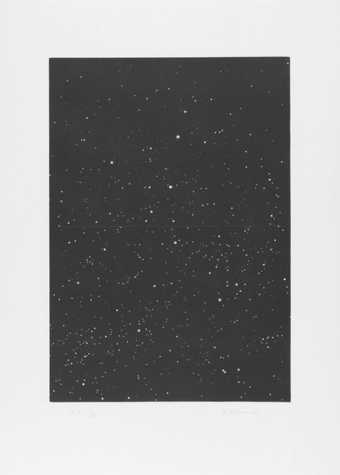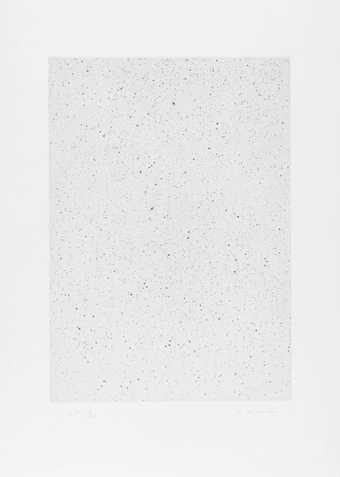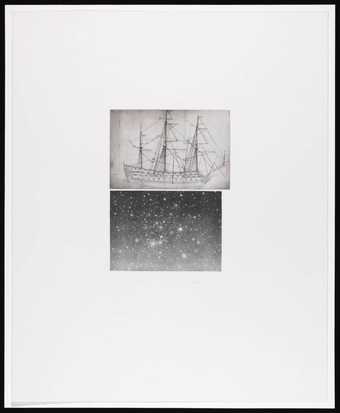
Not on display
- Artist
- Vija Celmins born 1938
- Medium
- Charcoal on paper
- Dimensions
- Support: 565 × 649 mm
frame: 611 × 694 × 38 mm - Collection
- ARTIST ROOMS Tate and National Galleries of Scotland
- Acquisition
- ARTIST ROOMS Acquired jointly with the National Galleries of Scotland through The d'Offay Donation with assistance from the National Heritage Memorial Fund and the Art Fund 2008
- Reference
- AR00164
Summary
Web #1 is a large charcoal drawing on paper of a spider’s web, based on a found photograph and not the direct observation of nature. It is signed and dated by the artist beneath the bottom right corner of the drawing. The charcoal drawing is positioned centrally on a large sheet of landscape-oriented paper and is contained by a relatively neat border – achieved by placing a piece of card around the image as the charcoal background is worked into the paper and to the edges, creating a softly feathered, rather than precise, linear border. The paper support has a slightly textured surface, so that the many layers of charcoal do not achieve a total black coverage of the off-white paper, but rather give the drawing a greyscale tonal quality. Explaining the working method for her charcoal drawings such as this one and Night Sky #19 1998 (Tate AR00163), the artist has stated: ‘I work the sheet with my hand, putting on charcoal in layers, and then I start taking it off with my hand, with my breath, and then with various kinds of erasers.’ (Quoted in Rippner 2002, p.28.) This can be understood as a kind of negative drawing – a process that moves backwards towards the original colour and surface of the paper.
The lines of the web are not crisply defined, appearing softly diffuse as they rise from the background, with charcoal dust clinging in places. There are brighter white areas of the web structure where there has been a more intensive use of the eraser to highlight the radiating strands of the web. The web stretches taut across the image surface, touching all four edges and creating strong diagonals across the picture plane. It is a drawing that is both produced mechanically (the electric eraser and photographic source) and laboriously, physically created by hand. Numerous fine threads are visible to the eye, but the charcoal atmosphere suffuses every line with a muted, cloaked character.
As the curator Jonas Storsve noted in 2006, ‘The spider web is the most recent motif to make its appearance in the artist’s drawings, although it figured in a painting in 1992’ (Storsve 2006, p.24). The curator Samantha Rippner has written of this introduction of the web into Celmins’s restricted range of imagery:
Celmins’s webs arrive absent their makers: no obvious signs of life or its intrinsic expressiveness are visible. Yet we are left, ironically, to contemplate the product of a painstaking effort – by both the spider and the artist. This is because Celmins does not imbue the spider with iconographical significance, as other artists have done. She takes a more pragmatic approach, identifying with it as a fellow builder of structures that, although possessing an inherent constancy, are each subtly different.
(Rippner 2002, p.9.)
Web #1 is one of five spider web works by Celmins in ARTIST ROOMS, the remaining four of which are examples of the artist’s wide-ranging printmaking practice (Tate AR00476–AR00479), produced and published two years after Web #1. Highlighting the close relationship between her drawing techniques and printmaking – mezzotint prints such as Untitled (Web 1) 2001 (Tate AR00476) in particular – Celmins has commented:
I believe working on the mezzotint, which I found to be very bizarre at first – working from black to white – influenced all those charcoal drawings. I started the drawings because I was beginning to think my painting was getting too concentrated, too tight, and I wanted to make work that was a little more open, maybe get more gesture in there with my hand. So I picked a fluid, dusty, malleable material like charcoal to trick myself into this mode.
(Quoted in ibid., p.28.)
Understanding the gestural potential of charcoal, Celmins subjects her chosen medium to analytic scrutiny, considering its various effects and qualities and feeding off the technical possibilities of printmaking. The artist reminds the viewer that the physical construction of the work figures equally to the structure of the representational subject matter itself.
Regarding the issue of scale within the web drawings, the poet and art critic Bill Berkson has observed:
the webs signal fresh turns in Celmins’ aptitude for pattern recognition and her way of running up an image in an indeterminate scale. One is tempted to see them as rendered actual-size, but their history as printed matter leaves us clueless as to what perspective originally claimed them.
(Berkson 2001, p.5.)
This confusing status – where the notion of the ‘original’ image is continually displaced – is cultivated by the artist’s purposeful ambiguity, reusing photographic sources across numerous works of art, varying only the density or pressure of the charcoal medium to produce infinite variations on a structurally tight theme. The question mark over any potential meaning, metaphorical, personal or otherwise, is allowed to hover, but is never answered.
Further reading
Bill Berkson, ‘Spellbound’, in Vija Celmins, exhibition catalogue, McKee Gallery, New York 2001, pp.3–5.
Samantha Rippner, The Prints of Vija Celmins, exhibition catalogue, Metropolitan Museum of Art, New York 2002.
Jonas Storsve and others, Vija Celmins: Dessins = Drawings, exhibition catalogue, Centre Pompidou, Paris 2006, reproduced p.143.
Stephanie Straine
May 2010
Does this text contain inaccurate information or language that you feel we should improve or change? We would like to hear from you.
Online caption
Celmins's intense monochromatic images of the night sky, based on photographs, focus on small and individual marks in the context of vastness. The images seem fragile because they record a specific human glimpse through a telescope or camera which is ephemeral and frozen in time. Celmins's serial exploration of her subjects, including the night sky, allows the artist to exploit the distinct characteristics of the variety of media she uses. This meticulous, translucent web is typical of her apparently fragile, ephemeral images. These images echo the web-like construction of the universe, a further preoccupation of the artist. Celmins has explained: “Maybe I identify with the spider. I'm the kind of person who works on something forever and then works on the same image again the next day."
Explore
- emotions, concepts and ideas(16,416)
-
- universal concepts(6,387)
-
- ephemerality(51)
- fragility(23)
You might like
-
Vija Celmins Night Sky #19
1998 -
Vija Celmins December 1984
1985 -
Vija Celmins Mount Holyoke
1987 -
Vija Celmins Untitled (Source Materials)
1999 -
Vija Celmins Night Sky 2 Reversed
2002 -
Vija Celmins Untitled (Web 1)
2001 -
Vija Celmins Untitled (Web 2)
2001 -
Vija Celmins Untitled (Web 3)
2002 -
Vija Celmins Untitled (Web 4)
2002 -
Vija Celmins Night Sky Woodcut
1997 -
Vija Celmins Concentric Bearings B
1984 -
Vija Celmins Web Ladder
2010 -
Vija Celmins Divided Night Sky
2010 -
Vija Celmins Reverse Galaxy
2010 -
Vija Celmins Alliance
1983

